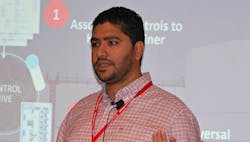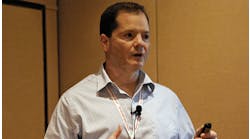“I/O HIVE has universal access to I/O, while Control HIVE does universal I/O discovery, allocation assignment and commissioning. This decouples hardware and software, enabling maximum flexibility and standardization.” Honeywell’s Michael Khilla explained the advantages of Honeywell’s virtualized I/O, control and IT environments.
What does the future process control and automation system look like? Freedom.
Most if not all of the rigid, hierarchical I/O and control systems that are defined by physical relationships will be replaced by more software-focused, often-virtual and physically decoupled incarnations. This new flexibility will allow next-generation process controls to be set up, operated, adjusted and maintained with far more efficiency than their clunky predecessors. This means fewer late changes causing physical reconfigurations and requiring manual load balancing, greater efficiency, and less risk of costly, time-consuming drags on project timelines and operations.
At the forefront of this tectonic shift toward digitalization and ease-of-use are the latest innovations within the Highly Integrated Virtual Environment (HIVE) I/O and HIVE Control within the latest Experion Process Knowledge System (PKS) architecture of Honeywell Process Solutions.
“Industrial facilities lose about $650 billion per year in unplanned downtime and shutdowns; only 25% of maintenance downtime is planned; and about 40% of today’s global installed base of automation systems are at least 20 years old,” said Michael Khilla, offering manager for Experion controls and engineering tools at Honeywell. “At the same time, operating expenses (OpEx) are taking on a leading role in many organizations, while reducing complexity is needed to overcome spiraling capital expenditures (CapEx) due to increasing risk of waste in big automation projects. This is why many users are starting to adopt virtualization and cloud-based applications. It’s time for a change!”
Khilla and Jim Schreder, fellow architect at Honeywell and system architect for HIVE, presented “What Does the Next Generation of Process Control Look Like?” at the Honeywell Users Group Americas 2022 in Orlando, Fla.
Enter the HIVE
Khilla reported that Experion PKS HIVE consists of three main aspects:
- I/O HIVE distributed I/O as an extension of modular, plant-floor equipment and in-the-field devices. It’s typically based on Honeywell’s CN100 controllers that look like a cluster and act as one big controller via a secure, high-speed network;
- Control HIVE with multiple, physical or virtual controllers presented as one virtual controller that acts as a shared computing resource. It’s based on Honeywell’s C300 controllers and process control network (PCN) and decouples control from events for greater flexibility and scalability; and,
- IT HIVE that works with offsite and cloud-based devices, and reduces IT lifecycle costs by reducing physical IT equipment at process facilities.
“Control HIVE is flexible and adaptable, with multiple physical controllers that are presented as a single HIVE controller,” explained Khilla. “It associates controls to a HIVE container, automatically allocates control tasks to available controller computing resources, and gives controllers universal access to I/O. This automating assignment and load balancing of controls eliminates hundreds of former steps, makes late changes more flexible, and then pools the collective resources of the controllers.”
Khilla added the Control HIVE also enables modular and parallel execution of projects by performing smart assignments for control applications, and using auto-discovery to commission I/O. “Traditional I/O and applications are bound to particular controllers, but I/O HIVE has universal access to I/O, and Control HIVE does universal I/O discovery, allocation assignment and commissioning,” said Khilla. “This lets users engineer strategies, associate and allocate with Control HIVE, test planned applications and graphics on a virtual engineering platform (VEP), and carry out late binding of controls and cabinets.
“This flexibility also increases process uptime and productivity. For example, in regular control system deployments, some controllers deal with more I/O than others, and they can hit limits or boundaries that can’t be modified without reallocating and making changes that can impact productivity. Control HIVE just adds I/O as needed through I/O HIVE, so it can make needed changes without impacting operations.”
In a live demonstration at HUG, Schreder reported that Control HIVE managed six physical or virtual controllers, each of which were responsible for a HIVE control application (HCA). They included three HCAs controlling a furnace, reactor or fractionator, and three others serving as backups or spares. These devices rely on high-availability R520.1 virtual local area networks (VLANs) that handle Control and I/O access to a fault-tolerant Ethernet (FTE) community, including parallel redundance protocol (PRP) for network redundancy.
“In short, Control HIVE means superior operations and maximum productivity,” concluded Khilla. “It can optimize processes by reducing control system hardware, cabinets and footprints by up to 15%. It decouples hardware and software, enabling maximum flexibility and standardization.
“It’s a scalable control platform for advanced processes,” he continued. “It’s a resilient, breakthrough approach to process availability due to HIVE’s infinite availability. And it’s got longevity because HIVE’s control applications can run on any qualified physical or virtual controller. This is how HIVE redefines process control and automation, and provides the foundation for resilient and more autonomous operations.”
The editors of Control, Control Design and Smart Industry are reporting live from 2022 Honeywell Users Group in Orlando, Florida, to bring you the latest news and insights from the event. When the event comes to a close, the best, most important coverage will be compiled into a report by the editors.
Register now to pre-order the report and be among the first to receive it in your inbox.






